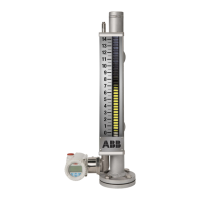Practical use of linearization/strapping table
Assuming for example that Volume will be used as the PV in
tanks with shape as shown in the pictures below, only two
points need to be enabled in the linearization/strapping table.
The reason for this is that the Volume is a linear function of the
Level being measured. In both cases, the volume is equal to the
factor of the area of the base of the tank by the liquid level.
Figure 31 Tank Volume Calculation
When volume is a linear function of the level, the Level can be
isolated as result of a factorization. In these cases, the
calculated PV could be considered as accurate as the accuracy
of the level measurement.
Cylindrical tanks are very common and the type described in
Figure 32 most of the times only requires two linearization
points because the volume is a linear function of the measured
V = AL x Level unless internal features of the tank like pipes
running through, agitators, entry ports, nozzles, etc… affect the
relationship between the volume and the measured level move
beyond the accuracy of the volume calculation outside of the
acceptable range. Some of the features mentioned above can
either decrease or increase the volume.
Calculation of the volume of fluid in a partially filled tank
sometimes represent a challenging calculation. For many
applications, the use of linearization tables allows overcoming the
challenge but in some others cases the calculation must be
deferred to the Control System to be able to use complex formulas.
Cylindrical tank in horizontal position are also very common in
the industry but unlike its relative in vertical position the partial
volume is not a linear function of the measured level. Below is
an example for calculating partial volume in such a tank:
Figure 32 Tank Volume Calculation
The figure 33 shows the chart for the plot of Level (mm) vs.
Volume (m3) for the tank in figure 32
Diameter = 1000 mm & Length = 2500 mm
The plot in blue shows the ideal characteristic as calculated for
an infinite number of points. The plot in red shows the Volume
output from a transmitter using a 2-point (1-segment)
linearization/strapping table with linearization points are 0 and
1000 mm. The plot in green shows an output characteristic
using a 6-point (5-segment) linearization/strapping table with
linearization points at 0, 200 mm, 400 mm, 600 mm, 800 mm &
1000 mm.
Figure 33 Level vs Volume - 2 Point Strapping
Figure 34 Level vs Volume - Multi-Point Strapping
From Figure 34 we can see the following:
• The accuracy of the linearization increases with the number of
points. More points, more accuracy.
• The characteristic of the volume vs level measured gets closer
to linear in the center of the tank. Choosing the points
strategically can improve the accuracy of the measurement.
Per se, we could set most of the points closer to the bottom
and top of the tank as follow: 0 mm, 100 mm, 200 mm, 800
mm, 900 mm & 1000 mm.

